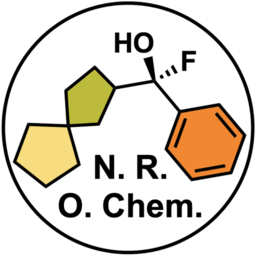Nicholas Reaction
The Nicholas reaction allows the conversion of propargylic alcohols to the corresponding substituted alkynes by the reaction with a nucleophile in the presence of dicobalt octacarbonyl and a Lewis acid.
Reaction Mechanism
The first step is the addition of dicobalt octacarbonyl to the propargylic alcohol. This generates a dicobalt intermediate that reacts with a Bronsted or Lewis acid to deliver the key dicobalt hexacarbonyl-stabilized propargylic cation. Subsequent addition of a nucleophile followed by a mild oxidation of the dicobalt complex gives the desired substituted product.
Examples
Experimental Procedure
To a stirred solution of the alkyne (1.2 mmol, 1.0 eq) in DCM (15mL) at 23 °C was added Co2(CO)8 (1.1 eq). The resulting mixture was stirred for 1 h before it was cooled to 0 °C. Then, the nucleophile (3.0 eq) was added. After stirring for 10 min, BF3∙Et2O (2.5 eq) was added, the resulting mixture was stirred for additional 3.5 h before it was quenched by addition of NaHCO3 solution. The layers were separated, and the aqueous layer was extracted with DCM. The combined organic layer was washed with brine, dried over Na2SO4 and concentrated under reduced pressure. The obtained residue (cobalt complex of the product) was used directly in the next step.
To a stirred solution of the above obtained cobalt complex in acetone (100 mL) at 0 °C were added ceric ammonium nitrate (4.4 eq) in three potions at a 10-minute interval, the resulting mixture was warmed to 23 °C and stirred for 1 h. The resulting mixture was then concentrated under reduced pressure. The obtained residue was then diluted with water and extracted with EtOAc. The combined organic extracts were washed with water, brine, dried over Na2SO4, and concentrated under reduced pressure. Flash column chromatography afforded the substituted alkyne (mixture of isomer, 5:1 dr, 72% yield).
Additional Examples
A flask was charged with propargylic alcohol (5.9 mmol, 1.0 eq). To this flask was added DCM (60 mL) followed by Co2(CO)8 (1.2 eq). The reaction mixture was allowed to stir at room temperature for 5 h. To this reaction mixture was added BF3·OEt2 (1.0 eq). After stirring for 5 min, the reaction mixture was quenched with sodium bicarbonate, and the aqueous layers were extracted with ethyl acetate. The combined organic layers were washed with brine, dried over sodium sulfate, and the solvent was removed in vacuo. The crude reaction mixture was purified using SiO2 gel column chromatography to delived the desired product (88% yield).
Learn More Named Reactions
[instagram-feed feed=2]










